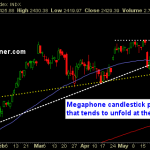The Nonfarm payrolls jobs report left investors disappointed, and the greenback under further pressure, as the United States economy created just 156,000 jobs in August while the official US unemployment rate moved higher to 4.4%. Financial markets had been expecting US payrolls to grow by 180,000 in August, and the US unemployment rate to continue to trend down. A broader measure that includes discouraged workers and those holding part-time jobs for economic reasons also was unchanged at 8.6%.
In addition to missing estimates, the previous months US payrolls job totals also were moved lower. The June figure was revised down from 231,000 to 210,000 while July fell from the initially reported 209,000 to 189,000, the Bureau of Labour Statistics said. Wage growth was also weak for the month, with average hourly earnings up 0.1% for an annualized rate of 2.5%. The average work week declined by 0.1 hour to 34.4 hours. The market reaction saw stock markets move higher, and the U.S dollar index move sharply lower, with the price of gold back towards 2017 trading highs.
The Chinese economy reported that its official manufacturing Purchasing Managers’ Index for the month of August, came in at 51.7, much better than the 51.3 reading financial market had been expecting. The uptick in August manufacturing was driven by strong production and a rise in new orders attributed to domestic demand, analysts said.
United States Gross Domestic Product (GDP) increased at a 3% annual rate in the April-June period, according to the second estimate from the US Commerce Department. The upward revision of the last estimate of 2.6% growth reported last month, reflected robust US consumer spending as well as strong business investment. Growth last quarter was the best since the first quarter of 2015 and followed a 1.2% pace in the January-March period. Economists had expected that second-quarter GDP growth would increase to 2.7%.
The US dollar index fell to its lowest level since January 2015, after North Korea fired a missile directly over Northern Japan. The missile landed in Pacific waters, around 1,100km away from the coast of Hokkaido, Japan, and subsequently sparked a flight into safe-haven asset classes.
















Leave A Comment